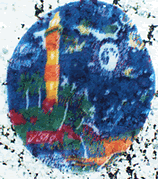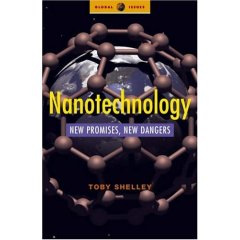Jun 30, 2007
The Straits Times
By Emma Philpott
Nanoparticles may be a boon to mankind and are common in products - yet little is known about their effects on humans and the environment
THE word 'nano' generally means very small. Scientifically, a nanometre is one-thousand millionth of a metre, or one-hundred thousandth the width of a human hair.
Nanoparticles are a description for very small particles that are less than 100 nanometres in size. This is about the same size as a virus or the size of a kink in a DNA chain. Very, very, small indeed.
Scientists are excited because, at these kinds of sizes, materials often begin to behave differently. Many of the ways we assume particles should behave, and are taught about in physics and biology lessons at school, simply do not occur at these sizes.
The reasons why this should be are not really understood at the moment, but much of it has to do with the fact that some of these nanoparticles consist of only a few atoms and so most of them are on the material's surface.
Even the larger nanoparticles have very large surface areas compared to their volume.
Some of these strange effects result in materials that have immense strength, virtually no resistance to electricity, incredible reactivity, or that can even emit light of specific colours when ultraviolet light is shone on them.
These new properties can be used to do some very 'cool' things.
For example, already in the shops are products such as underwear containing nanoparticles of silver which have been found to kill bacteria effectively.
Also, nanoparticles of iron can be pumped into land contaminated with persistent toxic chemicals in ground water, where they break down and effectively 'clean up'' the chemicals.
As we move to products still being developed, the possibilities get more amazing: carbon nanotubes are fibres made of carbon (the same material as coal and soot). These fibres are hollow and thinner than 100 nanometres across, and yet their strength can be 100 times that of steel.
Not only that, they can conduct both heat and electricity with hardly any resistance at all. Once these can be reliably mass-produced, we will get incredibly lightweight, strong composite bodies for use in cars and aircraft.
Using nanotechnology, it is thought we will also get solar cells that are much more efficient, batteries that store more power, and fuel that gives off almost no harmful emission when burnt.
Nanoparticles and nanotechnology, many people believe, are the future hope for realistic renewable energy and climate stability.
Possibilities get even more remarkable when we move to bio-products. Unlike larger particles, it has been found that some nanoparticles can easily move through membranes in the body. Thus, they can pass through the lungs into the blood, into the brain or right into the middle of human cells of a living person.
Scientists can attach clever little things onto these nanoparticles which could, in theory, either target and kill cancer cells or, once inside a cell could actually repair deformed DNA or other cell deformities.
This could revolutionise medicine and bring hope to millions of people suffering from countless diseases. This is not far-off science fiction - it is thought that it will actually become possible within the next 10 years.
The potential for nanoparticles being used for the good of humankind is endless and researchers from most fields of science are very excited about this area of science. If all these possibilities are already within reach, how many more amazing ways can we use nanoparticles as we begin to understand them better?
However, unfortunately, there is a flip side to these miraculous properties.
As people get more excited about the properties of nanoparticles, markets open up, companies are set up and people get keen to make money.
More and more nanoparticles are in consumer products now: nanosilver in washing machines, fullerenes (special nanoparticles of carbon) in face creams, nanotitanium-dioxide in sunscreen, and there are tonnes and tonnes of nanoiron particles being pumped into contaminated ground in the United States. All this is happening.
Meanwhile, science and research is way behind the enthusiasm of business, and is desperately trying to catch up.
Many research groups across the world are just starting to look at what effects these nanoparticles will have on the human body and the environment.
Some scientists have found that it is probably less important what the particles are actually made of and more important to know what their surface area is.
This starts to get into some pretty complex ideas about toxicity - but the upshot is that most researchers think that at least some of the nanoparticles may be very harmful to humans and the environment but no one knows which ones or what to look for yet.
There is little research or understanding about what happens to all the nanoparticles when they get into the environment and what they will do to plants, animals and friendly bacteria which we need in our finely balanced eco-system.
We know that some nanoparticles (we are not yet sure which ones) can pass through skin and lungs and also membranes in the body - so they can move into the blood and into cells and even into the brain. It is thought that they can interact with DNA.
Yet a growing variety of nanoparticles are already in the cosmetics which we smear over our skin every day. The sad fact is that cosmetics companies are not required, in any country, to state what goes into their products.
If the bulk material has not been used before, the companies have to state that they have tested it and found it to be safe. The test methods, however, do not have to be declared and as mentioned above, the nanoparticles probably do not behave in the same way as the bulk material anyway.
At the moment, scientists do not fully understand what makes a harmful nanoparticle or what they actually do to the body or environment, and there is absolutely no regulation about them at all. This is not just in
However, we should remember that lawsuits are the most effective kind of regulation, especially in the
Here in
They are leading the way in
Consumers need to be aware about the possible risks and rewards of nanoparticles so they can make their own informed decisions.
Meanwhile, the next time you are shopping, take a look at the products. Think twice about the ones advertising that they contain nanoparticles.
The writer is general manager of Cientifica







No comments:
Post a Comment